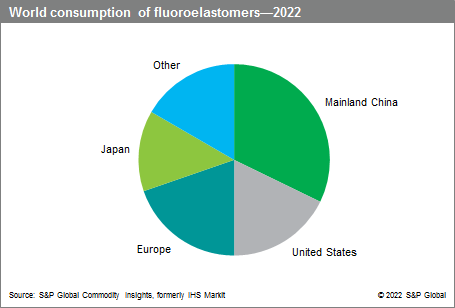Published November 2022
Fluoroelastomers are fluorine-containing polymers noted for their exceptional resistance to heat, weathering, and a wide assortment of fluids and chemicals, as well as for their exceptional sealing and mechanical properties. The working temperature range for fluoroelastomers is considered to be -26°C to 205–230°C, but for short working periods they will take even higher temperatures. Some perfluorocarbon elastomer types can resist temperatures up to 327°C. Components fabricated from fluoroelastomers, like certain O-rings, gaskets, and hoses, are essential for industries such as automotive, aerospace, and others, usually providing reliable, leak-free function. Fluoroelastomers are used mainly in seals and barrier layers subjected to environments too severe for other elastomers.
This report covers three major types of polymers:
- Fluorocarbon elastomers
- Fluorosilicone elastomers
- Perfluorocarbon elastomers, also referred to as perfluoroelastomers
The following pie chart shows world consumption of fluoroelastomers:

The global market for fluoroelastomers has been driven largely by the rapid development of the mainland Chinese automotive industry in the past decade. Total consumption of the three major fluoroelastomers (fluorocarbon elastomers or FKMs, fluorosilicone elastomers, and perfluorocarbon elastomers) is forecast to grow at an average of 4–5% per year through 2027. Major market drivers are new product developments in sealing applications (better performance), further tightening of emissions standards in many of the industrialized countries, and strong expansion and resurgence in automobile production. Fluorocarbon elastomers (FKMs) account for over 90% of the world market for fluoroelastomers. Mainland China has surpassed Western Europe and the United States since 2010 and is now the largest global market for FKMs.
For more detailed information, see the table of contents, shown below.
IHS Markit’s Chemical Economics Handbook – Fluoroelastomers is the comprehensive and trusted guide for anyone seeking information on this industry. This latest report details global and regional information, including

Key benefits
IHS Markit’s Chemical Economics Handbook – Fluoroelastomers has been compiled using primary interviews with key suppliers and organizations, and leading representatives from the industry in combination with IHS Markit’s unparalleled access to upstream and downstream market intelligence and expert insights into industry dynamics, trade, and economics.
This report can help you
- Identify trends and driving forces influencing chemical markets
- Forecast and plan for future demand
- Understand the impact of competing materials
- Identify and evaluate potential customers and competitors
- Evaluate producers
- Track changing prices and trade movements
- Analyze the impact of feedstocks, regulations, and other factors on chemical profitability


















